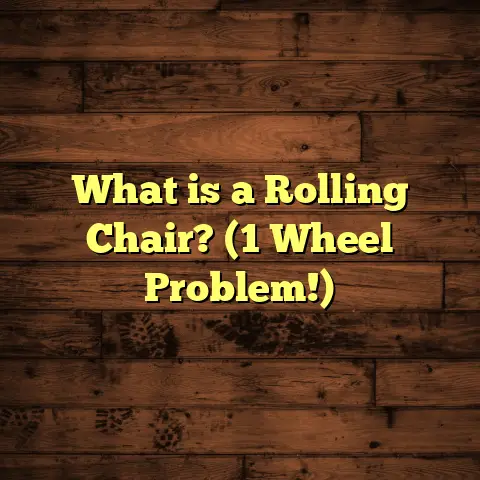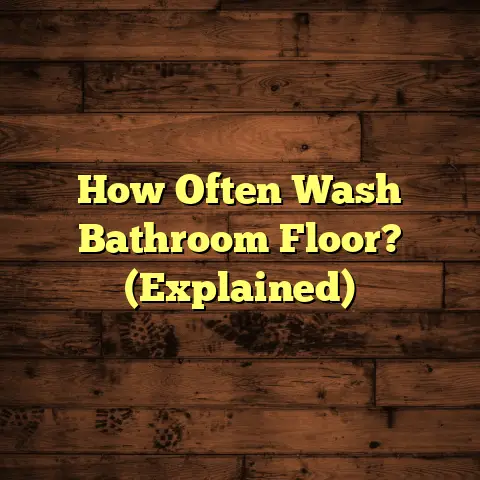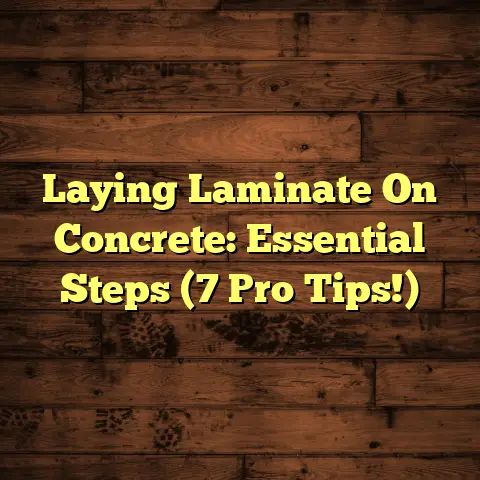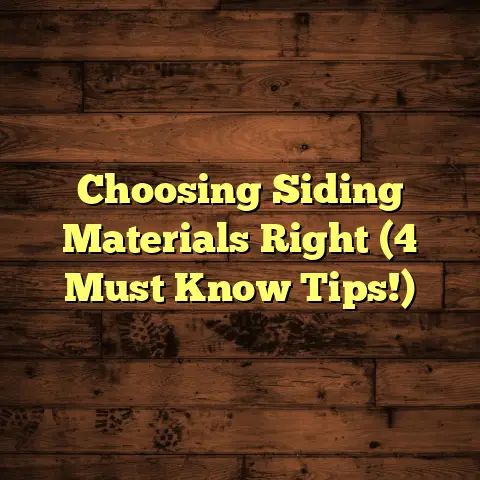Polished Concrete Types? (5 Finishes Exposed!)
I know, I know, when some folks hear “polished concrete,” they picture a cold, gray, industrial wasteland.
Right?
That’s a HUGE misconception, and honestly, it’s what keeps a lot of homeowners and designers from even considering it.
But let me tell you, polished concrete is anything BUT boring.
It’s an incredibly versatile flooring option that can be absolutely stunning, adding both character and warmth to any space.
Think sleek, modern homes, trendy restaurants, even cozy living rooms.
Polished concrete is popping up everywhere, and for good reason.
According to a recent study by MarketWatch, the polished concrete market is projected to reach \$3.5 billion by 2028, growing at a CAGR of 6.5% [^1^].
That’s a serious trend!
So, let’s dive in and expose the
truth about polished concrete.
We’ll explore the different types
of finishes and how they can
transform your space.
Section 1: Understanding Polished Concrete
Okay, so what exactly is polished concrete?
Simply put, it’s concrete that has been mechanically ground, honed, and polished with abrasives to achieve a desired level of sheen and smoothness.
Think of it like sanding wood, but on a much larger and tougher scale.
The process involves progressively finer grits of diamond-impregnated tools to refine the surface.
But it’s not just about making it shiny.
The basic components of concrete are cement, aggregate (like gravel or stone), water, and sometimes additives.
The type of aggregate, the cement mix, and the polishing process all contribute to the final look and performance.
For example, a concrete mix with a lot of quartz aggregate will give you a sparkly, elegant finish when polished.
The grinding and polishing process
is crucial.
We use heavy-duty
machines equipped with diamond
grinding pads.
These pads come in various grits, starting with coarse grits to remove imperfections and expose the aggregate, and ending with very fine grits to achieve the desired level of shine.
It’s a multi-step process that requires skill and experience.
I’ve seen DIY attempts go wrong more times than I can count.
Trust me, this is usually a job best left to the pros.
Section 2: The Five Types of Polished Concrete Finishes
Now, let’s get to the good stuff:
the different types of finishes!
Here are five popular options.
1. Honed Finish
A honed finish is all about subtlety. It has a matte or low-sheen appearance.
Think of it as a smooth, velvety surface, rather than a glaringly shiny one.
The texture is generally smooth to the touch but not slippery.
It’s achieved by grinding the concrete to a certain point, but stopping short of the high-gloss polish.
This finish is ideal for residential interiors where you want a sophisticated, understated look.
It’s also great for outdoor patios because it offers good traction, even when wet.
I often recommend honed finishes for clients who want a modern, minimalist aesthetic.
It’s also a great option if you’re concerned about glare.
To give you an idea, a honed
finish typically has a gloss
meter reading of between 10-30.
Compare that to a fully polished
floor, which can be 60 or higher.
Think of it like this: a honed
finish is like a satin dress,
while a full polish is like a
sequined gown.
Both are beautiful,
but they have very different vibes.
2. Full Aggregate Exposure
This finish is bold and dramatic!
Full aggregate exposure means grinding the concrete down far enough to reveal a significant amount of the aggregate within.
You’ll see a variety of stones, pebbles, and sand, creating a unique, textured surface.
The aesthetic appeal is all about the natural beauty of the materials.
You might see granite, quartz, marble chips, or even recycled glass, depending on the concrete mix.
Each aggregate type brings its own color and pattern to the table.
This finish is fantastic for commercial spaces and high-traffic areas because it’s incredibly durable and can hide minor imperfections.
I’ve used it in restaurants and retail stores where they want a statement floor that can withstand a lot of wear and tear.
It’s a bit like terrazzo, but with a more raw and industrial edge.
Keep in mind that full aggregate exposure requires a thicker concrete slab to ensure there’s enough aggregate to reveal.
We usually recommend a minimum slab thickness of 4 inches for this type of finish.
3. Partial Aggregate Exposure
Partial aggregate exposure is a happy medium between the honed finish and full aggregate exposure.
It involves grinding the concrete enough to reveal some of the aggregate, but not so much that it dominates the surface.
It strikes a nice balance between a refined look and the ruggedness of exposed aggregate.
This finish is perfect for residential living spaces, boutique shops, or offices where you want a touch of character without being too overwhelming.
I often suggest partial aggregate exposure for clients who want a unique floor that still feels comfortable and inviting.
It’s a great way to add texture and visual interest without sacrificing a clean, modern feel.
Think of it as adding a few carefully chosen accessories to an outfit – enough to make it interesting, but not so much that it’s distracting.
With partial exposure, you get a hint of the natural materials within the concrete, adding depth and dimension to the floor.
4. Salt and Pepper Finish
The salt and pepper finish is all about subtlety and elegance.
It’s achieved by lightly grinding the concrete to expose small aggregate particles, creating a look that resembles, well, salt and pepper!
This finish retains the concrete’s natural gray color, with tiny specks of lighter and darker aggregate scattered throughout.
It’s incredibly versatile and works well with a variety of design styles.
I’ve seen it used in modern homes, minimalist apartments, and even traditional spaces.
It’s a popular choice for those who want a clean, understated look that still has some visual interest.
The beauty of the salt and pepper finish is its simplicity.
It doesn’t try to be flashy or overpowering.
Instead, it provides a subtle texture and visual depth that complements the surrounding décor.
It’s a bit like a perfectly tailored suit – classic, timeless, and always in style.
5. Colored Polished Concrete
Now, let’s talk color!
Colored polished concrete opens up a whole new world of design possibilities.
We can use dyes, stains, or integral color admixtures to transform the concrete into virtually any hue you can imagine.
The versatility of color options is truly amazing.
You can create bold, vibrant floors that make a statement, or opt for more subtle, earthy tones that blend seamlessly with the surrounding environment.
I’ve used colored concrete to create stunning visual effects in a variety of environments, from bright, playful children’s rooms to sophisticated, elegant living spaces.
For example, I once used a deep blue dye to create a floor that resembled a tranquil ocean, and another time I used a warm, earthy stain to create a floor that felt like natural stone.
The possibilities are endless.
The key is to choose colors that complement the overall design aesthetic and create the desired mood.
Keep in mind that the color of the concrete can also affect the way light reflects in the room, so it’s important to consider the lighting when making your color selection.
Section 3: Benefits of Polished Concrete Finishes
So, why choose polished concrete over other flooring options?
Well, the benefits are numerous.
First and foremost, it’s incredibly durable.
Polished concrete can withstand heavy foot traffic, resist stains and scratches, and last for decades with proper maintenance.
I’ve seen polished concrete floors in commercial buildings that have been in use for over 20 years and still look great.
Secondly, it’s easy to maintain.
Unlike carpet or hardwood, polished concrete doesn’t require special cleaning products or complicated maintenance routines.
A simple sweep and occasional damp mop are usually all it takes to keep it looking its best.
Thirdly, it’s sustainable.
Concrete is a readily available material, and polishing it eliminates the need for additional floor coverings, reducing waste and conserving resources.
Plus, polished concrete can help improve energy efficiency by reflecting light and reducing the need for artificial lighting.
According to the U.S.
Green
Building Council, polished concrete
can contribute to LEED
certification by reducing energy
consumption and improving indoor
air quality [^2^].
And let’s not forget the cost- effectiveness.
While the initial investment in polished concrete may be higher than some other flooring options, its long lifespan and low maintenance costs make it a very economical choice over time.
I’ve done cost comparisons for clients showing that polished concrete can save them thousands of dollars over the life of the floor compared to carpet or tile.
Finally, polished concrete is aesthetically flexible.
It can complement a wide range of design styles, from minimalist to industrial to contemporary.
Whether you want a sleek, modern look or a more rustic, textured feel, polished concrete can be tailored to meet your specific needs.
Section 4: Real-Life Applications and Case Studies
Let’s take a look at some real- life examples of how polished concrete has been used to transform spaces.
I worked on a residential project where the homeowners wanted a modern, minimalist aesthetic.
We installed a salt and pepper polished concrete floor throughout the main living areas.
The result was a clean, elegant space that felt both sophisticated and inviting.
The homeowners were thrilled with the outcome, and they loved how easy it was to maintain.
Another project I worked on was a trendy restaurant in downtown.
The owners wanted a durable, eye-catching floor that could withstand heavy foot traffic.
We installed a full aggregate exposure polished concrete floor with a custom blend of aggregates.
The floor became a focal point of the restaurant, adding a unique and industrial vibe.
I have a client who owns a boutique clothing store.
She wanted a floor that was both stylish and practical.
We installed a partial aggregate exposure polished concrete floor with a light gray stain.
The floor perfectly complemented the store’s modern, minimalist design, and it was also easy to clean and maintain.
I could share dozens more stories, but the bottom line is that polished concrete is a versatile and beautiful flooring option that can be used in a wide variety of settings.
Conclusion
So, there you have it: a deep dive into the world of polished concrete finishes.
Hopefully, I’ve challenged some of your preconceived notions about this versatile material and shown you that it’s anything but cold and boring.
Polished concrete is a multifaceted flooring solution that merges beauty with practicality, offering durability, sustainability, and aesthetic flexibility.
I encourage you to consider polished concrete for your next renovation or construction project.
Whether you’re looking to create a sleek, modern home, a trendy commercial space, or a durable, low-maintenance floor, polished concrete has something to offer.
Don’t be afraid to rethink your preconceived notions and explore the possibilities.
You might be surprised at what you discover!
[^1^]: MarketWatch, “Polished Concrete Market Size 2023: Industry Analysis, Share, Growth, Trends, Opportunities Forecast Till 2028” (https://www.marketwatch.com/press- release/polished-concrete-market- size-2023-industry-analysis- share-growth-trends- opportunities-forecast-till-2028- 2023-05-24)
[^2^]: U.S. Green Building Council, “LEED v4 for Interior Design and Construction” (https://www.usgbc. org/leed)





